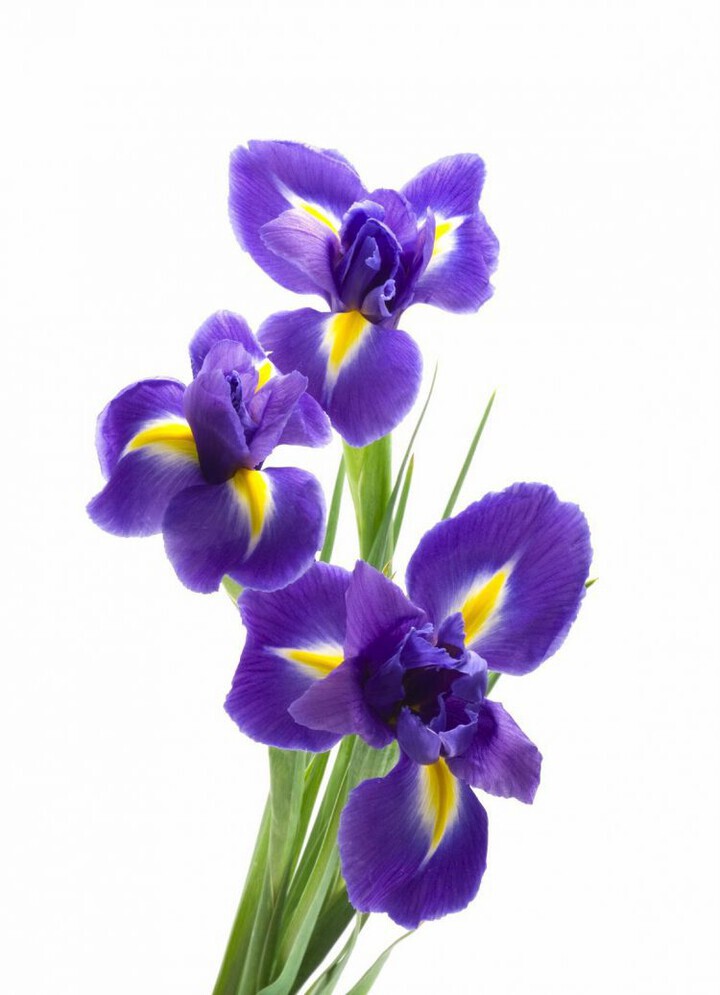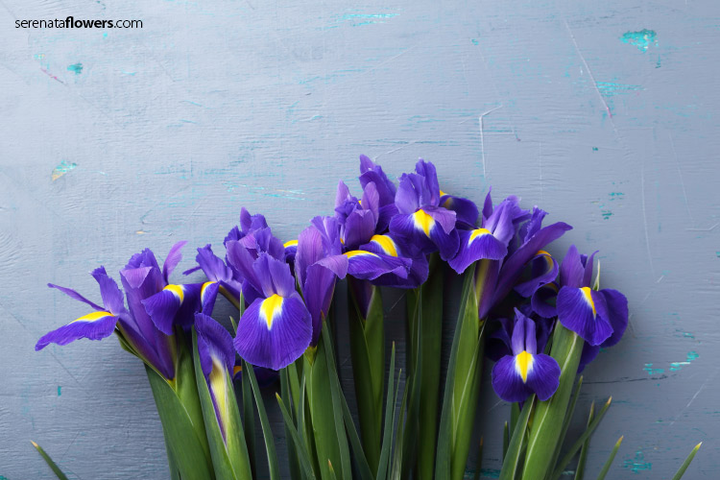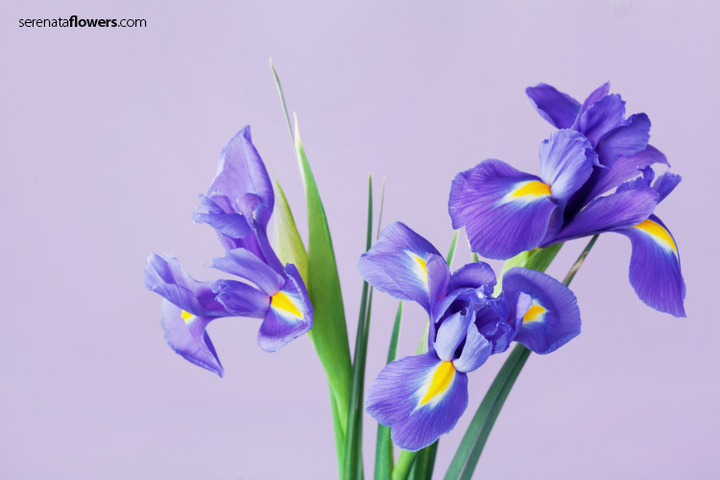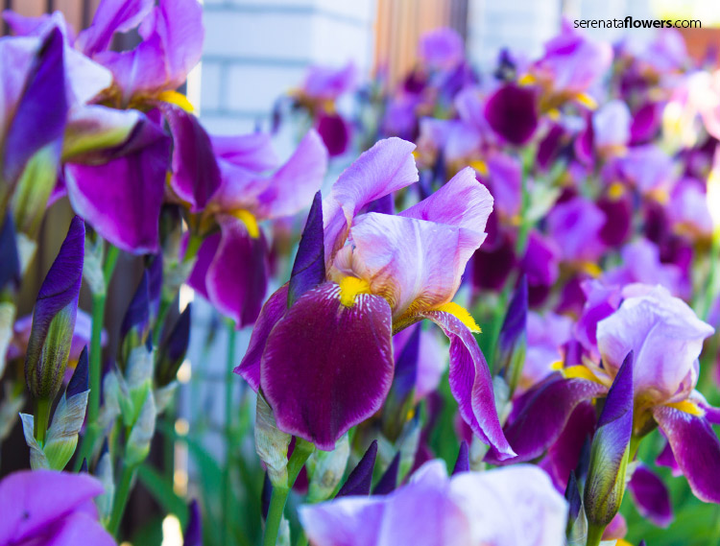
Iris comes from a genus of around 300 species of flowering plants, all of which boast an array of bold, impressive blooms. The name comes from the Greek word for ‘rainbow’ and signifies the wide diversity of flower hues available.
This prevalent garden flower comes in the shape of a perennial plant, which is often grown in the form of creeping, rhizome or bulb, particular in drier environments. These species boast lengthy, upright flowering booms, which are either simple in style, branched, flattened, circular, solid or hollow.
The rhizomatous species feature three to ten basal sword-shaped leaves, which grow in dense clumps, while the bulbous species feature basal leaves in a cylindrical shape.
Flower types
The inflorescences are shaped a little like a fan and feature one or more equally proportioned flowers. These grow on a peduncle or pedicel. The blooms showcase a number of sepals, which either spread or droop downwards, and are often nicknamed ‘falls’.
They grow from a narrow base, producing a wider, lengthened limb, often adorned with veined dots or lines. Some of the rhizomatous irises boast a tuft of short upright extensions in the centre of the blade. These are the plant’s filaments.

How to grow Iris
These picture-perfect flowers are almost maintenance-free, easy to grow, thrive in poor soil (in an open bed) and enjoy good sunlight.
For best results, plant iris flowers in late summer and place them in a sunny spot – six hours of sunlight per day will suffice. It’s important to use well-drained soil to ensure optimal growth. They prefer fertile, neutral to slightly acidic soil.
Once you’ve chosen a specie, prepare the beds and place each seedling or bulb a set distance apart, ensuring you give them room to breathe. Do not mulch.
Once the blooms have faded, break off seedpods and prune back the foliage in the spring months, refraining from trimming iris leaves post blooming as they carry on photosynthesis for next year’s growth. Once in place, water thoroughly and apply a low-nitrogen fertiliser. This can be added again in early spring.
Caring for your Iris plants
To avoid rhizome rot, shun high-nitrogen fertilisers (replacing them with low-nitrogen options instead). Another way to prevent rhizome rot is to refrain from mulching with organic matter. If needed, use shallow mulch in the spring months. Unlike bulbs, which thrive deep underground, rhizomes thrive best when exposed and enjoy both the sun and the air. When crowded by other plants or covered with soil, they’ll only rot.
When it comes to pruning your Iris flowers, remove and destroy foliage only if hit with heavy frost, as this will help to eliminate borer eggs. Another popular time to prune these plants is when the clumps lose vitality, become congested or stop blooming. This is usually after two to five years of being established. At this point, you may divide and replant good rhizomes in fresh soil.
The best time to replant Iris flowers is after first bloom. For best results, relocate them to a location that promises ‘wet feet, but dry knees’. When transplanting these plants, it’s wise to cut foliage back to two to three inches in length. This will encourage the rhizomes to re-establish themselves properly in their new home.

Pests and diseases
Iris plants are low-maintenance, drought-tolerant and deer-resistant. However, they are still susceptible to certain pests including borers. With this in mind, it’s important to check the plant’s fleshy roots for holes on a yearly basis, being sure to discard of any infested rhizomes.
Other common ailments to attack this plant include whiteflies, verbena bud moth, iris weevil, snails, nematodes, thrips and aphids.
Varieties
If you wish to achieve the deepest, purple-hued of flowers – opt for the ‘Mary Barnard’ iris specie. For a slightly stouter bloom, choose ‘Walter Butt’, which comes in the shape of a soft, opalescent off-white-mauve bloom, complete with a sweet scent.
Other popular varieties include:
Immortality: A tall bearded type of Iris flower, complete with pure white flowers, which showcase in the spring.
Feed Back and Earl of Essex: Two deep purple varieties with white flowers.
Jennifer Rebecca: A mauve pink beauty best suited to warmer climates.
Siberian Irises: These species come in a wide range of hues and stand out from the more common bearded irises.
Autumn Tryst: A remontant tall bearded plant, which grows to an impressive height of two to three feet tall. This specie boasts showy, bold, fragrant white flowers complete with a rosy lavender tinge. They thrive best when placed in full sunlight in a medium to moist soil. The first blooms arrive in May, which makes them a good choice for mixed perennial beds.
Baby Blessed: This bearded dwarf reveals a series of picture-perfect yellow flowers, which spring from eight to 15 inches. They arrive first in the spring and then sporadically throughout the season. They’re able to tolerate more shade and a wider range of environmental conditions than other bearded irises, which makes them a good option for border bed edges.
Lois Yellow (copper iris): This specie of Iris plant is a cultivar of the southern native copper iris plant. It grows between two and three feet in height and boasts a series of lush green, sword-like foliage, which lead to a show of pretty yellow flowers.
These bloom in the months of May and June. They thrive best when placed in full sunlight, however they are able to withstand partial shade. For best results, use a fertile, slightly acidic soil and ensure it is kept consistently moist to wet.
Beverly Sills: This tall bearded specie of iris plant has won a number of awards and grows to a height of two to three feet in height. The plant showcases an array of flamingo-pink flowers, complete with bold, flaring falls, which appear in June.
This Iris specie thrives in full sunlight and medium to moist, well-drained soil. For a bold show of flowers, plant in masses.

Cultivation
Iris are often planted as ornamental plants, and feature in both home and botanical gardens. When it comes to garden cultivation, there are a number of species to choose from, all of which come from various geographic origins.
Iris are easy to grow, and take well to a variety of garden soils, providing they’re well drained. I. reichenbachii and I. junonia are said to be the earliest blooms in existence, both blooming in early February and March in the Northern Hemisphere.
Other varieties include the tall bearded species including the Lemon-yellow Iris, German Iris, Sweet Iris, and Hungarian Iris. Then there are the dwarf forms to consider, comprising I. pumila, and the natural and horticultural hybrids, which consist of I. neglecta and I.squalens.
When do Iris bloom?
The bearded varieties tend to bloom from early spring up until the early summer months. When it comes to the beardless irises, the majority of species (particularly those in the Spuria subgroup) bloom from late spring to midsummer. Certain types of Siberian iris (Irissibirica) and Japanese iris (I. ensata) flower from mid-spring to early summer.
The meaning of Iris flowers
Iris folklore dates back to Ancient Greece, when the goddess Iris, who was said to have embodied the rainbow, represented the link between earth and heaven. In order to guide woman in their journey to heaven, many would plant purple irises over their graves.
Today, the Iris flower symbolises communication, hope, faith and wisdom – with the purple variants being associated with wisdom, the blue styles faith and hope, and the yellow variants with passion. White hues on the other hand are symbolic of purity.
Tips for growing Iris flowers
Few perennials promise as much colour. As such, these reliable plants are a popular option for both garden beds and borders. The late-blooming species allow green-fingered connoisseurs to enjoy an array of hot hues throughout much of the growing season. These plants are extremely versatile and suit most beds, as they range in size from tiny dwarf plants to giant plants, measuring over four feet tall.
The taller varieties are often used as background plants in perennial borders, while the smaller species are ideal for edgings in ornamental beds.
When it comes to growing Iris flowers, pick the specie wisely. From water-logged Japanese irises to well-drained bearded irises, there is an iris plant to suit just about any soil type. Both Xiphium, Pacific Coast and Siberian irises flourish in moist soils, while the miniature bulbous irises (Iris reticulata and I. danfordiae) necessitate outstanding drainage, which makes them a great option for rock gardens.
The majority of species prefer light shade or full sunlight, however they’re able to adapt to a wide range of temperature zones.
Remontant cultivars tend to be more productive than other species, so it’s therefore important to give them a little more water and fertiliser post first bloom. To encourage repeat blooms, deadhead any spent flowers.
For best results, plant irises from midsummer to early autumn. If you have the correct soil to hand, you can also plant Iris plants in containers.